Have you ever wondered how to create a playroom that encourages independence, fosters creativity, and nurtures your child’s developmental needs? Is your current play area overflowing with toys that never get used, or are you struggling to create an organized, functional space?
A Montessori playroom achieves all this by focusing on simplicity, accessibility, and intentionality. It is a child-centric environment supporting developmental milestones, promoting independence, and inspiring curiosity. Your child can thrive in an organized, engaging, and educational space with the right setup.
Stay with me as we explore the essential steps, practical tips, and expert advice to transform any room into the perfect Montessori playroom. Let’s make learning and play an enriching experience for your little one!
What is a Montessori Playroom?
A Montessori playroom is a thoughtfully designed space that aligns with the educational principles of Dr. Maria Montessori. The core idea behind a Montessori playroom is to create an environment that encourages children to explore, learn, and develop independently. Unlike traditional playrooms, which are often filled with overwhelming toys, a Montessori playroom is carefully curated with purposeful materials to foster the child’s development, creativity, and autonomy.
In a Montessori playroom, the focus is on simplicity, order, and accessibility. Everything in the room is within the child’s reach and organized in a way that promotes independent play and learning. The room is typically arranged into different activity zones—each designed to support a particular development area, such as practical life skills, sensory experiences, language development, and creative expression.
The Benefits of Montessori Playroom for Children

A Montessori playroom is about creating a beautiful space and crafting an environment that nurtures children’s development of key skills. The benefits of a Montessori-inspired playroom extend far beyond providing a safe space to play. This environment helps children grow in several critical ways, fostering autonomy, creativity, and important life skills.
Encouraging Independence and Autonomy
One of the primary benefits of a Montessori playroom is the promotion of independence. In a Montessori playroom, everything is within reach. Low shelves, accessible toys, and simple, organized systems allow children to independently select, use, and return materials. This freedom builds their confidence and self-reliance as they learn to make decisions and manage their environment. A key component of Montessori education is the emphasis on practical life skills. Children engage in activities like cleaning, dressing, and organizing, building self-sufficiency. By practicing these tasks daily in a playroom setting, children develop a sense of responsibility and mastery over their lives.
Promoting Focused and Purposeful Play
Unlike traditional playrooms filled with distracting toys, a Montessori playroom is designed to encourage focused, purposeful play. Each toy and activity is carefully chosen to stimulate a child’s cognitive and emotional development, fostering deep engagement. A Montessori playroom’s organized, minimalist environment reduces distractions, allowing children to focus on the task. Whether working with puzzles, building with blocks, or painting, children are encouraged to engage deeply with the activity, helping build their concentration and attention span.
Developing Fine and Gross Motor Skills

Montessori playrooms are also fantastic for promoting the development of both fine and gross motor skills. Activities like pouring, threading beads, or using tongs help children develop hand-eye coordination and fine motor skills. These skills are necessary for tasks like writing, dressing, and self-care. The Montessori playroom provides opportunities for children to refine these skills through purposeful activities. While fine motor skills are important, gross motor skills—like balance, coordination, and large muscle development—are also encouraged in the Montessori playroom. Activities like climbing, dancing, or jumping help children build strength and coordination, which are vital for overall physical development.
Supporting Emotional and Social Growth
In addition to intellectual development, a Montessori playroom supports emotional and social growth. The autonomy children gain from being in charge of their play fosters self-esteem and emotional regulation. Children who choose activities and resolve challenges independently build emotional resilience. They learn to persevere through challenges, manage frustration, and celebrate successes. This emotional self-regulation is crucial for social development and personal growth. While Montessori environments are designed for independent work, they encourage collaboration and sharing. Group activities like cooperative games or shared art projects foster social interaction, teaching children the value of working together, sharing, and respecting others.
Encouraging Creativity and Imagination
A Montessori playroom is an ideal space to foster creativity and imagination. Unlike structured toys that dictate how children should play, Montessori materials are open-ended, allowing children to use their creativity and imagination to invent new play methods. Montessori materials such as wooden blocks, art supplies, and musical instruments are designed to encourage creative thinking. These materials are not about following instructions but creating, building, and expressing oneself.
Children can engage in imaginative play, whether building a castle, creating a piece of art, or composing a song. Many Montessori toys are designed to engage children in creative problem-solving. Whether it’s figuring out how to balance objects, arrange shapes, or solve puzzles, children use their imagination to navigate challenges and think outside the box. This kind of play encourages flexibility in thinking and enhances cognitive development.
How to Set Up a Montessori Playroom?
Setting up a Montessori playroom is a thoughtful process beyond simply arranging toys and furniture. The goal is to create an environment that is child-centered, organized, and conducive to hands-on learning.

Choosing the Right Space
The first step in setting up a Montessori playroom is selecting the right space. Ideally, this should be a room or corner in your home that is accessible to your child, free from distractions, and allows easy movement and exploration. Ensure that the space is easily accessible, meaning it should be free of any obstacles that might prevent your child from freely moving in and out.
Consider placing the playroom near common areas where family activities occur but without too much noise or distraction. Natural light and ventilation are essential in a Montessori playroom. Bright, open spaces inspire creativity and energy, so aim for a room with plenty of natural light. If natural light is limited, choose soft, warm artificial lighting that isn’t too harsh or distracting.
Include Nature in the Space
- Use Natural Materials in Furniture and Decor
Opt for solid wood, bamboo, or other natural materials for furniture and toys. Wooden toys and materials are often more durable and engaging than plastic ones, offering a tactile experience that connects children to nature. Natural materials also provide a calming aesthetic that promotes focus and concentration. Incorporate woven baskets, cotton rugs, and linen cushions to add warmth and texture to the room. These materials provide sensory experiences for young children and keep the space organic and connected to the natural world. - Add Live Plants to the Space
Introducing live plants into your Montessori playroom is one of the easiest and most impactful ways to bring nature indoors. Plants contribute to a calming atmosphere, improve air quality, and teach children valuable lessons about responsibility and care. - Incorporate Natural Light
Natural light is a crucial aspect of both Montessori and nature-based learning environments. It enhances the mood, stimulates creativity, and supports children’s well-being. Maximizing natural light creates a warm, inviting space that encourages active engagement and focus. - Use Nature-Inspired Art and Decor
Hang simple nature-themed artwork on the walls—such as botanical prints, landscapes, or illustrations of animals. These pieces can be educational and visually stimulating, reinforcing the connection between the child and the world outside. Incorporate natural objects like pinecones, stones, or driftwood as part of your decor. These items can double as educational tools or sensory objects. Children can explore these objects’ textures, colors, and shapes while learning about the natural world. - Bring Natural Sensory Experiences to the Room
Nature provides a wealth of valuable sensory experiences for children’s development. Incorporating these elements into the playroom creates an environment where children can engage with their senses meaningfully. Create sensory bins filled with natural materials such as dried leaves, sand, small rocks, or pine needles. These bins provide tactile exploration and encourage fine motor development as children sift, pour, and explore different textures. Consider adding elements that engage the auditory senses, such as wind chimes, a rainmaker, or an indoor fountain. These gentle sounds will help create a peaceful, nature-inspired atmosphere that promotes calmness and focus.
Transform Your Classroom with Custom Furniture Solutions
Use Child-Sized Furniture
Choose small, lightweight tables and chairs that are easy for your child to move around and adjust. Ensure they can comfortably sit at the table with their feet touching the floor. This encourages them to draw, sort, or work with Montessori materials more. Low shelves or storage units should be used to display toys and materials within the child’s reach. This promotes independence because children can easily access their needs without adult help.
Avoid closed cabinets or drawers that make materials harder to access. Low shelves or storage units should be used to display toys and materials within the child’s reach. This promotes independence because children can easily access their needs without adult help. Avoid closed cabinets or drawers that make materials harder to access.
Create Activity Zones
- Practical Life Zone
Set up a corner for practical life activities like pouring, sorting, or folding. Include materials like small pitchers, tongs, and simple household tasks like sweeping or dusting. These activities teach children important life skills while promoting concentration and independence. - Sensorial Zone
Create a space with sensory activities like textured fabrics, sorting trays, or sound boxes. This helps children engage their senses and fine-tune their sensory perception, fostering brain development. - Art and Creativity Zone
A small corner dedicated to art and creativity can include drawing materials, clay, or crafting supplies. Art promotes self-expression and fine motor skills while encouraging creativity.
Create Order and Routine Place
A key principle of Montessori education is creating an environment that promotes order, structure, and routine. When children know where to find things and can predict the flow of their day, they develop confidence and independence. Setting up a Montessori playroom that encourages these qualities allows your child to thrive in a space where they feel safe, capable, and in control.
Montessori environments emphasize accessibility, so opt for low shelves or storage units that allow your child to access and return toys, books, and materials independently. Keeping items within their reach ensures they can choose and organize their activities without assistance. Organize toys and materials by category—such as puzzles, blocks, books, or art supplies—so your child can easily find their needs. Use picture labels or simple word labels to identify where each item belongs. This helps children understand where to put things away and reinforces the idea of order.
Transform Your Classroom with Custom Furniture Solutions
What Should Be in a Montessori Playroom?

Montessori Furniture
- Low Tables and Chairs
Montessori furniture is designed for children to sit easily and comfortably. Small, low tables and chairs enable children to engage in activities at their level. For example, children can sit at a table to work on puzzles, do arts and crafts, or read books. This setup promotes a sense of autonomy, as kids can independently access and use furniture without relying on an adult for assistance. - Low Bookshelves
A Montessori bookshelf is designed to store books in a way that is easily accessible to children. Books are placed with the cover facing out, allowing children to browse and select books independently. - Floor Beds
Unlike traditional cribs, these beds are placed directly on the floor to give babies and toddlers the freedom to independently get in and out of bed. This type of bed aligns with the Montessori principle of freedom and independence. The child can move in and out of bed, promoting self-regulation and choice. It helps children develop confidence in their abilities, knowing they can explore their room and return to bed when ready to sleep. - Lockers and Cubbies
In any Montessori playroom or classroom, organization is key to fostering independence and responsibility in children. Lockers and cubbies are essential pieces of furniture that help keep the space tidy and allow children to take ownership of their belongings. These storage solutions contribute to a child’s ability to learn how to manage their personal space and belongings, a core principle of the Montessori method.
Transform Your Classroom with Custom Furniture Solutions
Montessori Toys
- Practical Life Toys
Practical life toys help children develop everyday skills they will use. These toys focus on cleaning, dressing, cooking, and caring for the environment, teaching important motor skills, and fostering independence and responsibility. - Sensorial Toys
Sensory toys are designed to engage and refine the five senses—sight, touch, smell, sound, and taste. These toys help children develop a deeper understanding of the world around them and aid in cognitive development by helping children categorize and differentiate sensory information. - Mathematics Toys
Montessori mathematics toys are designed to introduce children to fundamental mathematical concepts, such as counting, addition, subtraction, geometry, and patterns. These toys make abstract concepts tangible and accessible for children. - Language Toys
Language toys promote communication skills, vocabulary expansion, and early literacy. These toys focus on developing spoken and written language by helping children connect sounds with letters, words, and ideas. - Fine Motor Skill Toys
Fine motor toys enhance children’s ability to perform small, precise movements using their hands and fingers. These toys help strengthen hand muscles, improve coordination, and prepare children for writing, dressing, and eating tasks. - Gross Motor Skill Toys
Gross motor toys support the development of large muscle groups for activities like walking, running, jumping, and balancing. These toys often require a larger range of motion and focus on physical activity to build strength and coordination.

What Activities Can a Kid Do in a Montessori Playroom?
In a Montessori playroom, children can choose activities that match their interests and developmental levels while still guided by intentional learning principles. The key is offering a variety of hands-on activities that promote independence, focus, and exploration.
Practical Life Activities
Practical life activities are the heart of Montessori education. These activities allow children to practice real-life tasks that build fine motor skills, coordination, and independence. Children can clean and tidy up their own space in a Montessori playroom. Simple tasks like wiping down tables, dusting shelves, or sweeping the floor teach responsibility and promote a sense of order.
These activities also provide a practical way to learn about cleanliness and caring for their environment. Learning to fasten buttons, zip zippers, or tie shoelaces is an important developmental milestone. Montessori materials often include dressing frames or clothes with large buttons and zippers to help children practice these skills independently.

Sensorial Activities
The Montessori approach places a strong emphasis on sensory learning. Sensorial activities engage a child’s senses—sight, sound, touch, taste, and smell—to help them explore the world around them and build awareness of their environment. Children can explore textures, colors, shapes, or sizes by sorting and categorizing objects.
Music and sound exploration is an essential part of Montessori learning. Kids can use sound boxes with different materials to learn volume, pitch, and rhythm. Musical instruments, such as xylophones, drums, or maracas, allow children to experiment with sound, which can also improve auditory skills and concentration.
Art and Creative Expression
Creative activities allow children to express themselves, build confidence, and develop fine motor skills. The Montessori playroom is filled with opportunities for creative expression through various art forms. Providing children with materials such as crayons, markers, watercolor paints, and brushes encourages them to explore their artistic side.
Art activities develop fine motor skills and allow children to express their emotions and creativity in a safe space. Working with clay or playdough can enhance a child’s fine motor skills and creativity. Cutting, gluing, and assembling materials like fabric, paper, and buttons for a collage project helps children develop fine motor skills and hand-eye coordination. Crafting activities also encourage patience and the ability to follow steps in a process, promoting perseverance.
Language Development Activities
In a Montessori playroom, children are encouraged to explore language through various hands-on activities. A well-stocked bookshelf with age-appropriate books invites children to explore stories, build vocabulary, and practice listening skills. Reading aloud, storytelling, or even acting out a favorite story with puppets are all activities that support language development. Montessori playrooms often include letter tiles, movable alphabets, or sandpaper letters, allowing children to explore letter shapes and sounds. This tactile experience is a powerful way to help children connect the written word with its sound, laying the foundation for reading and writing.
Math Activities
Mathematical learning is introduced in a Montessori playroom through concrete materials and hands-on activities, making abstract concepts more tangible and understandable for young children. Montessori materials, such as counting beads or number cards, help children understand the concept of numbers and counting.
Children learn about quantity, order, and number relationships by physically manipulating objects. Simple measuring cups and scales allow children to experiment with volume and weight. By measuring different amounts of liquids, solids, or objects, they gain an understanding of size, comparison, and proportions, laying the groundwork for more advanced math concepts later on.

Social and Emotional Learning Activities
Activities that foster cooperation, empathy, and self-regulation are essential components of the Montessori method. Children can play pretend using toys like dolls, figures, or miniature household items. Role-playing allows children to express their emotions, practice social roles, and develop empathy as they imagine themselves in different situations. In a Montessori playroom, group activities help children develop teamwork skills. Whether working together to build something or participating in a group project, collaboration fosters a sense of community and shared responsibility.
Conclusion
Creating a Montessori playroom is about designing an environment that nurtures your child’s growth and encourages them to explore, create, and learn independently. You can create a space that fosters autonomy, creativity, and concentration using child-sized furniture, organized materials, and purposeful toys. Remember, a Montessori playroom is more than just a place to play—it’s an environment that helps children develop into confident, capable learners ready to face the world.
Ready to transform your home with a Montessori playroom? Start small, focus on simplicity, and watch your child blossom in their personalized learning haven! If you want to design the perfect Montessori children’s room for your needs, contact us!
Discover Our Full Range of Products
Get access to our comprehensive catalog featuring top-quality furniture and play equipment for kindergartens and schools.








